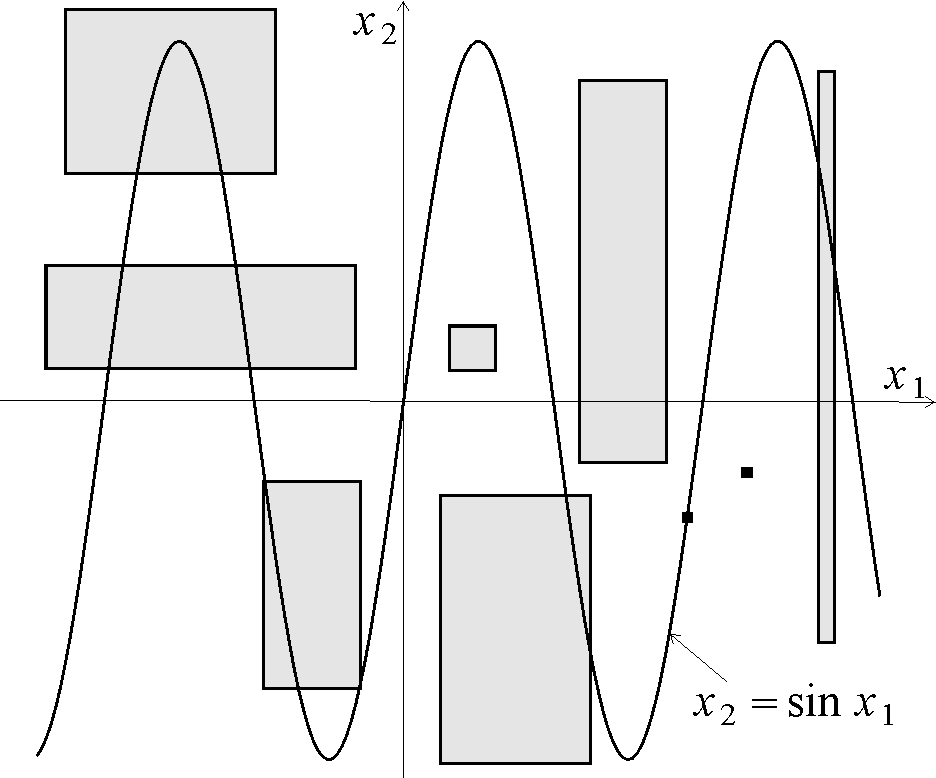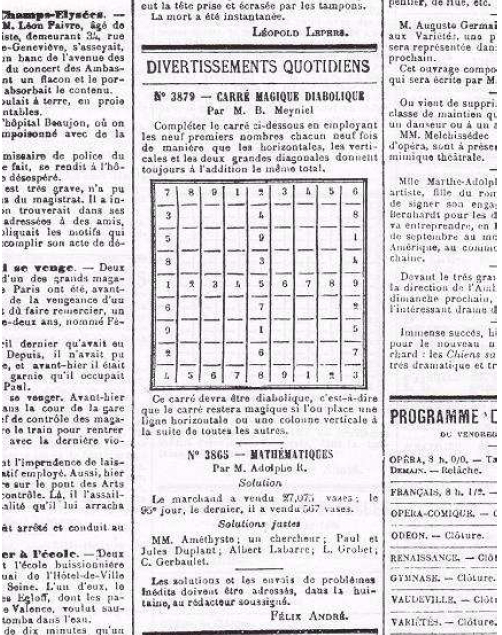|
Constraint Satisfaction
In artificial intelligence and operations research, constraint satisfaction is the process of finding a solution through a set of constraints that impose conditions that the variables must satisfy. A solution is therefore an assignment of values to the variables that satisfies all constraints—that is, a point in the feasible region. The techniques used in constraint satisfaction depend on the kind of constraints being considered. Often used are constraints on a finite domain, to the point that constraint satisfaction problems are typically identified with problems based on constraints on a finite domain. Such problems are usually solved via search, in particular a form of backtracking or local search. Constraint propagation is another family of methods used on such problems; most of them are incomplete in general, that is, they may solve the problem or prove it unsatisfiable, but not always. Constraint propagation methods are also used in conjunction with search to make ... [...More Info...] [...Related Items...] OR: [Wikipedia] [Google] [Baidu] |
Artificial Intelligence
Artificial intelligence (AI) is the capability of computer, computational systems to perform tasks typically associated with human intelligence, such as learning, reasoning, problem-solving, perception, and decision-making. It is a field of research in computer science that develops and studies methods and software that enable machines to machine perception, perceive their environment and use machine learning, learning and intelligence to take actions that maximize their chances of achieving defined goals. High-profile applications of AI include advanced web search engines (e.g., Google Search); recommendation systems (used by YouTube, Amazon (company), Amazon, and Netflix); virtual assistants (e.g., Google Assistant, Siri, and Amazon Alexa, Alexa); autonomous vehicles (e.g., Waymo); Generative artificial intelligence, generative and Computational creativity, creative tools (e.g., ChatGPT and AI art); and Superintelligence, superhuman play and analysis in strategy games (e.g., ... [...More Info...] [...Related Items...] OR: [Wikipedia] [Google] [Baidu] |
Joseph Fourier
Jean-Baptiste Joseph Fourier (; ; 21 March 1768 – 16 May 1830) was a French mathematician and physicist born in Auxerre, Burgundy and best known for initiating the investigation of Fourier series, which eventually developed into Fourier analysis and harmonic analysis, and their applications to problems of heat transfer and vibrations. The Fourier transform and Thermal conduction#Fourier's law, Fourier's law of conduction are also named in his honour. Fourier is also generally credited with the discovery of the greenhouse effect. Biography Fourier was born in Auxerre (now in the Yonne département of France), the son of a tailor. He was orphaned at the age of nine. Fourier was recommended to the Bishop of Auxerre and, through this introduction, he was educated by the Benedictine Order of the Convent of St. Mark. The commissions in the scientific corps of the army were reserved for those of good birth, and being thus ineligible, he accepted a military lectureship on mathematics. ... [...More Info...] [...Related Items...] OR: [Wikipedia] [Google] [Baidu] |
Graph Coloring
In graph theory, graph coloring is a methodic assignment of labels traditionally called "colors" to elements of a Graph (discrete mathematics), graph. The assignment is subject to certain constraints, such as that no two adjacent elements have the same color. Graph coloring is a special case of graph labeling. In its simplest form, it is a way of coloring the Vertex (graph theory), vertices of a graph such that no two adjacent vertices are of the same color; this is called a vertex coloring. Similarly, an ''edge coloring'' assigns a color to each Edge (graph theory), edges so that no two adjacent edges are of the same color, and a face coloring of a planar graph assigns a color to each Face (graph theory), face (or region) so that no two faces that share a boundary have the same color. Vertex coloring is often used to introduce graph coloring problems, since other coloring problems can be transformed into a vertex coloring instance. For example, an edge coloring of a graph is just ... [...More Info...] [...Related Items...] OR: [Wikipedia] [Google] [Baidu] |
Interval Propagation
In numerical mathematics, interval propagation or interval constraint propagation is the problem of contracting interval domains associated to variables of R without removing any value that is consistent with a set of constraints (i.e., equations or inequalities). It can be used to Propagation of uncertainty, propagate uncertainties in the situation where set estimation, errors are represented by intervals. Interval propagation considers an estimation problem as a constraint satisfaction problem. Atomic contractors A contractor associated to an equation involving the variables ''x''1,...,''x''''n'' is an operator which contracts the intervals [''x''1],..., [''x''''n''] (that are supposed to enclose the ''x''''i'''s) without removing any value for the variables that is consistent with the equation. A contractor is said to be ''atomic'' if it is not built as a composition of other contractors. The main theory that is used to build atomic contractors are based on Interval arithmet ... [...More Info...] [...Related Items...] OR: [Wikipedia] [Google] [Baidu] |
Scheduling (production Processes)
Scheduling is the process of arranging, controlling and optimizing work and workloads in a Production (economics), production process or manufacturing process. Scheduling is used to allocate plant and machinery resources, plan human resources, plan production processes and purchase materials. It is an important tool for manufacturing and engineering, where it can have a major impact on the productivity of a process. In manufacturing, the purpose of scheduling is to keep due dates of customers and then minimize the production time and costs, by telling a production facility when to make, with which staff, and on which equipment. Production scheduling aims to maximize the efficiency of the operation, utilize maximum resources available and reduce costs. In some situations, scheduling can involve random attributes, such as random processing times, random due dates, random weights, and stochastic machine breakdowns. In this case, the scheduling problems are referred to as "stochastic s ... [...More Info...] [...Related Items...] OR: [Wikipedia] [Google] [Baidu] |
Boolean Satisfiability Problem
In logic and computer science, the Boolean satisfiability problem (sometimes called propositional satisfiability problem and abbreviated SATISFIABILITY, SAT or B-SAT) asks whether there exists an Interpretation (logic), interpretation that Satisfiability, satisfies a given Boolean logic, Boolean Formula (mathematical logic), formula. In other words, it asks whether the formula's variables can be consistently replaced by the values TRUE or FALSE to make the formula evaluate to TRUE. If this is the case, the formula is called ''satisfiable'', else ''unsatisfiable''. For example, the formula "''a'' AND NOT ''b''" is satisfiable because one can find the values ''a'' = TRUE and ''b'' = FALSE, which make (''a'' AND NOT ''b'') = TRUE. In contrast, "''a'' AND NOT ''a''" is unsatisfiable. SAT is the first problem that was proven to be NP-complete—this is the Cook–Levin theorem. This means that all problems in the complexity class NP (complexity), NP, which includes a wide range of natu ... [...More Info...] [...Related Items...] OR: [Wikipedia] [Google] [Baidu] |
Eight Queens Puzzle
The eight queens puzzle is the problem of placing eight chess queens on an 8×8 chessboard so that no two queens threaten each other; thus, a solution requires that no two queens share the same row, column, or diagonal. There are 92 solutions. The problem was first posed in the mid-19th century. In the modern era, it is often used as an example problem for various computer programming techniques. The eight queens puzzle is a special case of the more general ''n'' queens problem of placing ''n'' non-attacking queens on an ''n''×''n'' chessboard. Solutions exist for all natural numbers ''n'' with the exception of ''n'' = 2 and ''n'' = 3. Although the exact number of solutions is only known for ''n'' ≤ 27, the asymptotic growth rate of the number of solutions is approximately (0.143 ''n'')''n''. History Chess composer Max Bezzel published the eight queens puzzle in 1848. Franz Nauck published the first solutions in 1850. W. W. Rouse Ball (1960) "The Eight Queens Problem" ... [...More Info...] [...Related Items...] OR: [Wikipedia] [Google] [Baidu] |
Sudoku
Sudoku (; ; originally called Number Place) is a logic puzzle, logic-based, combinatorics, combinatorial number-placement puzzle. In classic Sudoku, the objective is to fill a 9 × 9 grid with digits so that each column, each row, and each of the nine 3 × 3 subgrids that compose the grid (also called "boxes", "blocks", or "regions") contains all of the digits from 1 to 9. The puzzle setter provides a partially completed grid, which for a well-posed problem, well-posed puzzle has a single solution. French newspapers featured similar puzzles in the 19th century, and the modern form of the puzzle first appeared in 1979 puzzle books by Dell Magazines under the name Number Place. However, the puzzle type only began to gain widespread popularity in 1986 when it was published by the Japanese puzzle company Nikoli (publisher), Nikoli under the name Sudoku, meaning "single number". In newspapers outside of Japan, it first appeared in ''The Conway Daily Sun'' (New Hamp ... [...More Info...] [...Related Items...] OR: [Wikipedia] [Google] [Baidu] |
Possible World
A possible world is a complete and consistent way the world is or could have been. Possible worlds are widely used as a formal device in logic, philosophy, and linguistics in order to provide a semantics for intensional and modal logic. Their metaphysical status has been a subject of controversy in philosophy, with modal realists such as David Lewis arguing that they are literally existing alternate realities, and others such as Robert Stalnaker arguing that they are not. Logic Possible worlds are one of the foundational concepts in modal and intensional logics. Formulas in these logics are used to represent statements about what ''might'' be true, what ''should'' be true, what one ''believes'' to be true and so forth. To give these statements a formal interpretation, logicians use structures containing possible worlds. For instance, in the relational semantics for classical propositional modal logic, the formula \Diamond P (read as "possibly P") is actually true if and ... [...More Info...] [...Related Items...] OR: [Wikipedia] [Google] [Baidu] |
Java (programming Language)
Java is a High-level programming language, high-level, General-purpose programming language, general-purpose, Memory safety, memory-safe, object-oriented programming, object-oriented programming language. It is intended to let programmers ''write once, run anywhere'' (Write once, run anywhere, WORA), meaning that compiler, compiled Java code can run on all platforms that support Java without the need to recompile. Java applications are typically compiled to Java bytecode, bytecode that can run on any Java virtual machine (JVM) regardless of the underlying computer architecture. The syntax (programming languages), syntax of Java is similar to C (programming language), C and C++, but has fewer low-level programming language, low-level facilities than either of them. The Java runtime provides dynamic capabilities (such as Reflective programming, reflection and runtime code modification) that are typically not available in traditional compiled languages. Java gained popularity sh ... [...More Info...] [...Related Items...] OR: [Wikipedia] [Google] [Baidu] |
Prolog
Prolog is a logic programming language that has its origins in artificial intelligence, automated theorem proving, and computational linguistics. Prolog has its roots in first-order logic, a formal logic. Unlike many other programming languages, Prolog is intended primarily as a declarative programming language: the program is a set of facts and Horn clause, rules, which define Finitary relation, relations. A computation is initiated by running a ''query'' over the program. Prolog was one of the first logic programming languages and remains the most popular such language today, with several free and commercial implementations available. The language has been used for automated theorem proving, theorem proving, expert systems, term rewriting, type systems, and automated planning, as well as its original intended field of use, natural language processing. See also Watson (computer). Prolog is a Turing-complete, general-purpose programming language, which is well-suited for inte ... [...More Info...] [...Related Items...] OR: [Wikipedia] [Google] [Baidu] |
Constraint Programming
Constraint programming (CP) is a paradigm for solving combinatorial problems that draws on a wide range of techniques from artificial intelligence, computer science, and operations research. In constraint programming, users declaratively state the constraints on the feasible solutions for a set of decision variables. Constraints differ from the common primitives of imperative programming languages in that they do not specify a step or sequence of steps to execute, but rather the properties of a solution to be found. In addition to constraints, users also need to specify a method to solve these constraints. This typically draws upon standard methods like chronological backtracking and constraint propagation, but may use customized code like a problem-specific branching heuristic. Constraint programming takes its root from and can be expressed in the form of constraint logic programming, which embeds constraints into a logic program. This variant of logic programming is due ... [...More Info...] [...Related Items...] OR: [Wikipedia] [Google] [Baidu] |



